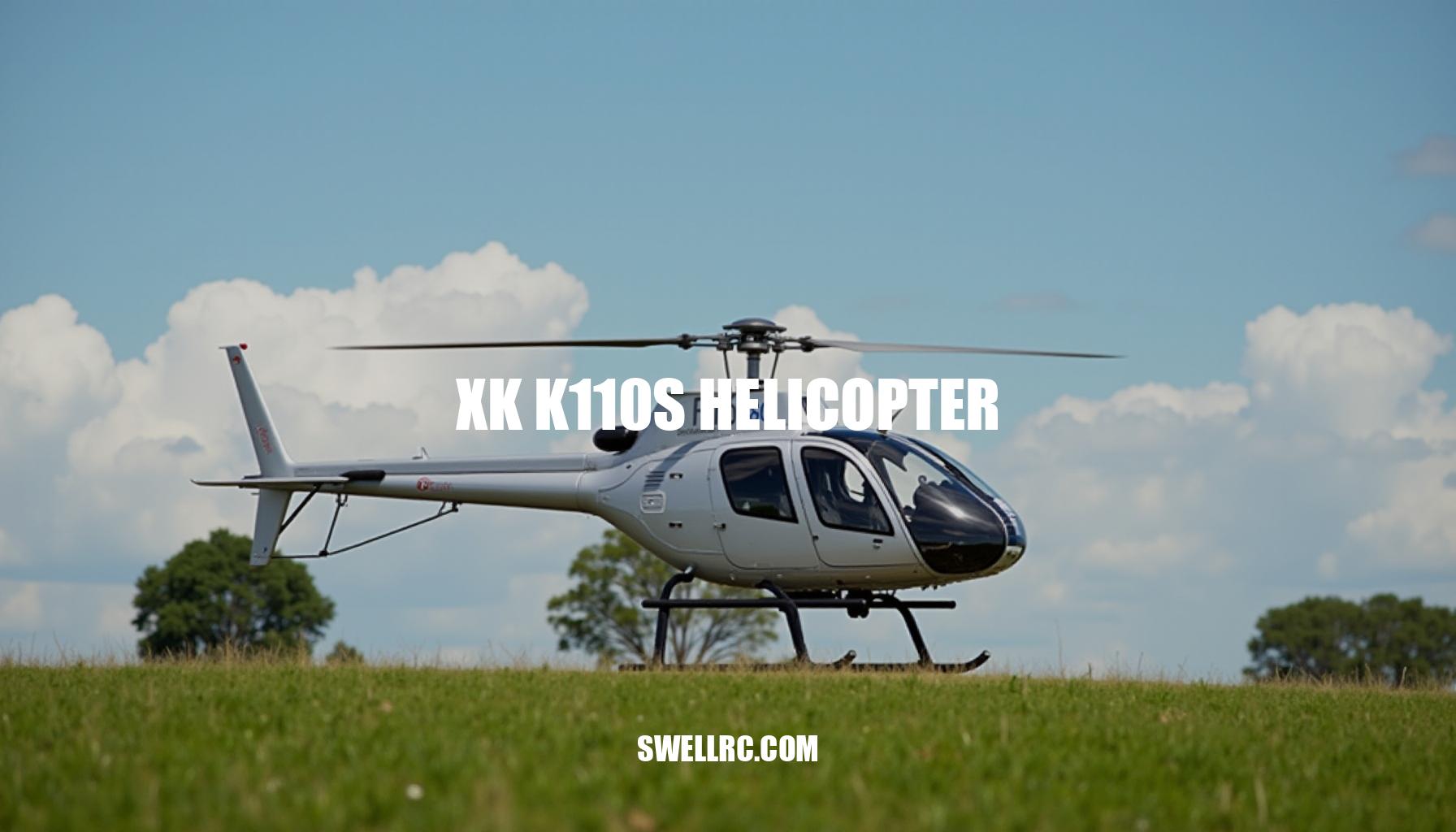XK K110S Helicopter Review: A Beginner-Friendly and Advanced RC Flying Experience
The XK K110S helicopter offers an impressive leap for anyone stepping into the world of RC helicopters. Unlike typical micro collective-pitch models that can feel nervous and twitchy, the K110S delivers a silky-stable hover and smooth transitions into crisp forward flight, making it ideal for beginner RC training. This model stands out among XK helicopters thanks to its advanced flybarless design and powerful brushless motor, providing the punch needed for agile 3D flight maneuvers without the harshness often found in toy-class alternatives.
When comparing the XK K100 vs K110S, the K110S clearly serves pilots looking for more sophisticated performance, while the K100 remains a reliable stepping stone for those wanting a simpler, compact experience. The K110S’s 6-axis stabilization system is another key feature, allowing pilots to customize assistance levels as their skills improve. For those seeking a robust, high-quality RC helicopter that bridges the gap between beginner-friendly handling and advanced flight capabilities, the XK K110S helicopter is truly a top contender.
Design and Build Quality: Compact Yet Fearlessly Capable
Picking up the XK K110S, the first surprise is how solid it feels for a micro heli frame. The canopy is flexible yet resilient, crafted to withstand minor impacts typical in RC helicopter durability tests. Its frame combines lightweight plastic and carbon elements, enhancing structural integrity without sacrificing agility.
The main rotor head employs a clean flybarless design, engineered to shrug off inevitable bumps and provide precise control. A powerful brushless motor drives the main rotor, offering reliable power while keeping weight low, essential for maintaining responsiveness and flight time. The tail utilizes a simple, efficient brushed setup that’s easy to replace when it wears down.
The rotor head geometry and FBL controller synergize to create a hard-to-find balance: quick cyclic response without feeling nervous in hover. Essentially, the airframe flexes just enough to survive tip-overs while maintaining stiffness to keep the disc tracking true. This is crucial when considering collective pitch vs fixed pitch configurations—micro helis with collective pitch, like the K110S, deliver superior maneuverability, including 3D capabilities and better wind handling, compared to fixed-pitch alternatives.
For context, larger toy-grade helicopters such as the Double Horse 9101 (link) emphasize size over precision and durability, while ultra-light fixed-pitch micros such as the Hero RC H911 (link) feel beginner-friendly but can’t match the K110S’s 3D capability or wind handling.
| Feature | Description | Benefit |
|---|---|---|
| Flybarless Design | Simplified rotor head without a flybar | Improved responsiveness and easier maintenance |
| Brushless Motor | High efficiency, low maintenance main motor | Reliable power delivery and reduced weight |
| Micro Heli Frame | Combination of lightweight plastic and carbon | Crash resilience with structural stiffness |
| Rotor Head Design | Geometrically optimized for stability | Balanced cyclic responsiveness and hover stability |
| Collective Pitch vs Fixed Pitch | Ability to adjust blade pitch dynamically | Enhanced 3D flight capability and wind handling |
Overall, the XK K110S occupies a sweet spot in the market where parts remain inexpensive, the frame offers impressive crash resilience, and the mechanics are precise enough to reward careful setup and piloting skill. Its thoughtful integration of flybarless design, robust materials, and brushless motor technology make it an excellent choice for pilots seeking performance and durability in a micro RC helicopter.
Flight Performance and Control Precision
In the air, the XK K110S feels like a micro helicopter you can truly grow with, thanks to its impressive 3D flight capabilities and advanced engineering. Equipped with a 6-axis gyro, it offers excellent gyro stabilization that holds attitude confidently, especially in stabilized (6G) mode. This makes initial hovers and nose-in practice far less stressful for beginners.
Transitioning to 3D mode, the heli wakes up: flips and rolls feel clean, the tail authority is predictable, and the collective pitch provides that satisfying punch you need for quick recoveries.
Understanding collective pitch is key—it means the blades change angle together, offering instant up or down thrust without waiting for head speed to adjust. Combined with the 6-axis gyro, the XK K110S can easily switch between being a calm trainer and a lively stunt machine. During my test flights, I started with slow circuits, then increased rates for sustained inverted flight and quick tic-tocs.
This demonstrates the heli’s excellent control responsiveness, which keeps advanced pilots engaged yet remains tame enough for newer flyers, especially when easing in via dual rates and expo settings.
For performance context, consider the following comparison:
| Model | Flight Style | Size & Power | Best For |
|---|---|---|---|
| XK K110S | 3D flight with gyro stabilization | Micro size with collective pitch | Balanced trainer and 3D stunt flying |
| WLToys V950 | Powerful and fast 3D | Bigger and more powerful | Open fields and advanced pilots |
| Eachine E200 RC Helicopter | Scale and stable flight | Compact volume with stability focus | Beginners and scale enthusiasts |
Overall, the XK K110S review and specs highlight a learning curve that feels just right: quick early wins, then plenty of depth to master as your thumbs catch up. With its gyro stabilization, control responsiveness, and true collective pitch mechanics, it stands out as a versatile option for hobbyists interested in micro 3D helicopters.
Battery Life, Charging, and Maintenance Essentials
Expect about 6–8 minutes of flight time per 1S pack under typical mixed flying conditions, slightly less when performing continuous 3D maneuvers, and a bit more during gentle hovering. For optimal results and to extend battery life, I recommend using quality 1S 450 mAh lithium polymer battery packs, charging them at around 0.5–1C with proper LiPo charging techniques, and storing them at 3.75–3.85V per cell when not in use. Proper battery care includes keeping batteries cool, avoiding fully discharging them, and rotating through multiple packs to prevent heat buildup.
Using a balanced multi-port charger to charge several packs simultaneously can save time and help maintain consistent battery health.
The power demands and battery care requirements for this micro helicopter are similar to larger toy-class models like the Double Horse Volitation 9053 RC Helicopter. However, the K110S’s collective-pitch design places even more emphasis on maintaining healthy LiPos for consistent punch and performance.
For effective micro helicopter upkeep and maintenance tips, consider the following best practices:
- Check blade grips, linkages, and main shaft screws thoroughly after any crashes.
- Keep the tail motor and gears clean; replace the tail motor when its holding power diminishes.
- Inspect the main gear mesh regularly; listen carefully for any unusual whining or grinding noises that could indicate wear.
- Allow batteries and motors to cool between flights to prevent overheating and prolong lifespan.
- Keep spare parts such as canopies, skids, and main gears on hand as cheap insurance against unexpected hangar delays.
Comparison: How the XK K110S Stacks Up in Its Class
The K110S stands out as the best RC helicopter under $200, offering excellent value for money with its collective-pitch design that significantly contrasts with fixed pitch models. In the ongoing discussion of xk k100 vs k110s, the K110S excels by delivering true aerobatic capabilities thanks to its refined flight controller tuning and improved tail hold. This makes it a versatile choice bridging the gap between trainer vs advanced performer roles.
Unlike fixed pitch helicopters, the K110S’s collective pitch allows for better wind authority and dynamic maneuvers, allowing pilots to grow their skills progressively. Beginners benefit from the stabilized 6G mode to get comfortable, while more experienced flyers can unlock full 3D aerobatics as they improve.
| Feature | K110S | Yuxiang F09 Black Hawk | Notes |
|---|---|---|---|
| Flight Type | Collective Pitch | Fixed Pitch | Collective pitch offers aerobatics and wind resistance |
| Flight Modes | 6G Stabilized, 3D Acro | Scale, Docile | K110S is better for training and advanced performance |
| Camera Capability | No (Focus on Flying) | Yes (Scale Footage) | For aerial recording, refer to Best RC Helicopter with Camera roundup |
| Upgrade Path | Better LiPos, Spare Blades, Advanced Transmitter | Limited | K110S rewards skill improvement rather than constant upgrades |
For those wondering about upgrading, the path is clear: start with the stock radio and battery, then gradually invest in higher quality LiPos and an SFHSS-compatible or multi-protocol transmitter to unlock finer control. Spare main blades help fine-tune your helicopter’s feel in flight, enhancing the overall experience without breaking the bank.
In summary, the K110S is a standout choice for anyone seeking a well-rounded helicopter with strong upgrade path options, balancing beginner-friendly features with advanced performance. Whether you’re moving from a fixed pitch or diving into collective pitch for the first time, this heli offers an outstanding price-to-performance ratio—proof that you don’t have to spend a fortune to fly like a pro.
Final Thoughts: Why the XK K110S Helicopter Is Worth Your Time
From the first hover to the first clean inverted pass, the XK K110S made me smile. It’s rare to find a micro 3D heli that can be both a confidence-building trainer and a legit 3D platform. If you’re new to RC flying, the 6-axis stabilization and low disc loading make it reassuring, perfectly aligning with what you’d expect in beginner RC training.
For the more experienced, the punchy brushless main motor and precise flybarless tuning mean you can practice tighter lines and more aggressive transitions without lugging a big field kit. This enthusiast RC helicopter bridges the gap between beginners and seasoned pilots, making it a versatile choice.
In my xk k110s review, I found it best suited for:
- Curious beginners ready to commit to real rotorcraft skills
- Intermediate pilots wanting daily-stick time
- Stunt flyers seeking backyard-friendly practice
Highlighting the pros and cons, you’ll appreciate its:
- Pros: Tough, affordable parts and crash-friendly design; brushless main motor with lively collective response; 6G/3D modes scaling from beginner to advanced; excellent value and easy transportability.
- Cons: Short flight times typical of 1S micros; brushed tail motor is a wear item; light weight means wind limits; benefits from careful setup and periodic maintenance checks.
After countless hours of tinkering, I can honestly say the XK K110S reignited my love for flying models—and it keeps earning pack after pack in my daily rotation.
Frequently Asked Questions
- How durable is the xk k110s helicopter for beginners?
Very durable for its class. The flexible canopy, resilient landing skids, and lightweight frame absorb minor crashes well. Blade grips, linkages, and the main gear are inexpensive and easy to swap. While no CP heli is crash-proof, the K110S is among the most forgiving micros to learn on. - What’s the difference between the xk k110 and the xk k110s?
The K110S generally features refined flight controller tuning, smoother power delivery, and improved tail hold compared with earlier K110 batches. In practice, the S version feels a bit more locked-in in 6G and more confident during 3D transitions, while keeping parts compatibility and the same approachable size. - Can the xk k110s handle outdoor flying?
Yes—light to moderate wind is manageable thanks to collective pitch authority and a capable gyro. It’s still a micro, so strong gusts will push it around. Pick calmer mornings or evenings for best results and switch to higher rates or 3D mode as your skills improve. - How long does the xk k110s battery last on a single charge?
Typically 6–8 minutes per 1S 450 mAh pack. Expect closer to 5–6 minutes with aggressive 3D and 7–8 minutes with gentle hovering and circuits. Proper LiPo care—cool-down between flights and storage at 3.75–3.85V—helps maintain consistent flight times. - Is the xk k110s worth buying compared to similar RC helicopters?
For the price, it’s one of the best values in micro collective-pitch. You get brushless main power, effective stabilization, and crash-friendly parts costs. If you want camera features, look elsewhere; if you value skill-building and aerobatics, the K110S is a standout choice.


